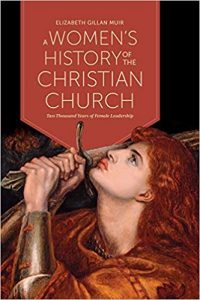Writing A Women’s History of the Christian Church
Writing A Women’s History of the Christian Church, two thousand years of female leadership
 In WOMANWORD, A Feminist Lectionary and Psalter, Miriam Therese Winter, one of the Medical Mission Sisters, wrote, “Who will retrieve our stories from the void of the unremembered? Who will believe we were who we are and did all the things we do?”
In WOMANWORD, A Feminist Lectionary and Psalter, Miriam Therese Winter, one of the Medical Mission Sisters, wrote, “Who will retrieve our stories from the void of the unremembered? Who will believe we were who we are and did all the things we do?”
Marilyn Färdig Whiteley and I used that psalm (with permission, of course!) at the beginning of our earlier book, Changing Roles of Women within the Christian Church in Canada (University of Toronto Press). Unfortunately it seems as applicable today as it was then.
Why did I write A Women’s History of the Christian Church, two thousand years of female leadership (University of Toronto Press)?
Recently, I was honoured to be part of a panel of church historians celebrating women’s international day, asked to talk about a woman in the history of the church whom we admired.
The exercise revealed the incredible lack of knowledge among theological students and even some of their mentors about the roles women held in the history of Christianity.
So I felt this book had to be written – to recover the feisty and powerful women who gave so much to the life and work of Christianity: house church leaders, prophets, presbyters, even bishops in the early days.
For example, did you know that all the evidence points to a major competition between Mary Magdalene (definitely NOT a prostitute) and St Peter? Mary was called the Apostle to the Apostles, the most significant one of them all. Did you know that there were ordained female deacons and deaconesses up to the eleventh century? The evidence is there.
Did you know that women co-founded and founded churches, denominations, and several orders? Such as the Ursulines, the Daughters of Charity, the Salvation Army, several Pentecostal churches, Christian Science and the Quakers? Did you know that women have been ordained to all ecclesiastical positions in churches around the world including the archbishopric?
Over the centuries, however, in spite of their contributions, women have been chastised, hidden, enclosed, imprisoned, “wiped out”, their work deliberately erased or omitted from histories and other records, yet they persisted with their efforts, believing they had a call to do so.
For example, until very recently, the apostle Junia mentioned in the New Testament was always translated as Junias, a male, because translators could not conceive of a female apostle. One welcome exception was the translation by the thirteenth century Benedictine nun, Gertrude the Great, who recognized Junia as female.
Women, of course, were those mainly accused of being witches – and burnt – because, as their accusers wrote, women were “a necessary evil…a domestic danger.” Estimates range from 60,000 to a million women sent to the stake as witches.
In 1631,the English educator, Mary Ward, walked more than 1,500 miles from Belgium to Rome in ill-fitting shoes, to visit Pope Urban VIII to gain approval for her European girls’ schools. Mary was trying to restore the Roman Catholic Church to England at that time. Instead of recognition, the pope threw her in jail as a “schismatic,” meddling in the affairs of men. (After her death, Mary was recognized by the Church as an “incomparable woman.”)
In the nineteenth century, the religious publication, the Methodist Magazine, refused to print an account of the life of the popular preacher Elizabeth Tonkin Collett, even though it had been written by a male minister and submitted by her son. The editor said it might set a “precedent to young females…” Elizabeth had built seven chapels, organized seven Methodist societies, led one religious revival, looked after eleven children, and was supported by her husband. And Methodism was one major religious denomination in which women were especially active and in most periods, well received.
I look at all these activities and more (in both the Roman Catholic and Protestant traditions) in the book which is formatted so that it can be used as a text for church history or women’s studies courses. I hope it will help give some permanence to the women “who did all the things we do”.
My research for such a work was obviously extensive; but my intention was to combine my own research with that of so many other fascinating studies undertaken by women and men restricted to specific locations or groups.
I hope I have in some measure accomplished this, but it would involve more than one 400-page book to do justice to everything written to date. And hopefully, one day, some church historian will put together all the work done on the history of men as well as women in the church and produce a valid record of one hundred per cent of the population. As Jarena Lee, the African Methodist Evangelist (AME) preacher, wrote: “If the man may preach, because the Savior died for him, why not the woman seeing he died for her also? Is he not a whole Savior, instead of a half one? As those who hold it wrong for a woman to preach, would seem to make it?”
***
Liz Muir (Dr Elizabeth Gillan Muir) taught at Emmanuel College, University of Toronto and was on the faculty of St Paul’s College, University of Waterloo. She holds a doctorate from McGill University. Her first major work was Petticoats in the Pulpit, the story of early nineteenth-century Methodist women preachers in Upper Canada. You can visit her on her website, www.lizmuir.ca
A Women’s History of the Christian Church: Two Thousand Years of Female Leadership
 Tracing two thousand years of female leadership, influence, and participation, Elizabeth Gillan Muir examines the various positions women have filled in the church. From the earliest female apostle, and the little known stories of the two Marys – the Virgin Mary and Mary Magdalene – to the enlightened duties espoused by the nun, the abbess, and the anchorite, and the persecutions of female “witches,” Muir uncovers the rich and often tumultuous relationship between women and Christianity.
Tracing two thousand years of female leadership, influence, and participation, Elizabeth Gillan Muir examines the various positions women have filled in the church. From the earliest female apostle, and the little known stories of the two Marys – the Virgin Mary and Mary Magdalene – to the enlightened duties espoused by the nun, the abbess, and the anchorite, and the persecutions of female “witches,” Muir uncovers the rich and often tumultuous relationship between women and Christianity.
Offering broad coverage of both the Catholic and Protestant traditions and extending geographically well beyond North America, A Women’s History of the Christian Church presents a chronological account of how women developed new sects and new churches, such as the Quakers and Christian Science. The book includes a timeline of women in Christian history, over 25 black-and-white illustrations, a glossary, and a list of primary and secondary sources to complement the content in each chapter.
Category: Contemporary Women Writers, How To and Tips































I am so looking forward to reading this book!
I hope you enjoy it. I look forward to your comments after you read it.
Best.
Liz